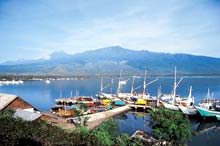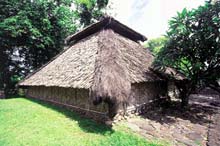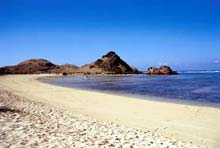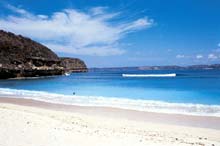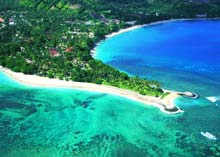What can you do & see in Lombok Island
Trekking Rinjani Mountain in Lombok Island
Over 20 villages surround Mt. Rinjani and there are many routes up the mountain, but the main access is from Senaru in the north and Sembalun Lawang to the east. The challenging three-day Rinjani Trek route from Senaru to the crater rim (Plawangan), down to the stunning crater lake then on to Sembalun Lawang, is considered one of the best treks in South East Asia. Those heading for the summit usually prefer to start in Sembalun Lawang.
A model for ecotourism in Indonesia, the community-based activities are focussed on the Rinjani Trek Centre in Senaru, the most popular starting point for the tough trek. Developed with New Zealand Government assistance since 1999, the Rinjani Trek Centre embodies under one roof (satu atap) the unique partnership of the National Park, tourism industry and local communities that has been forged to manage and protect the Rinjani mountain environment.
Coral and diving in Lombok Island
Three small islands, surrounded by coral, The Gilis, off Lombok's west coast, are fast becoming one of her main drawcards. Dive centres with all the high tech equipment and professional instructors ensure that visiting divers at all levels of experience and ability can dive in waters that have more varieties of fish than anywhere in the world - and that includes The Great Barrier Reef and Red Sea.
Gili Trawangan now appears to head the list as the most popular island - it has long had a reputation as the 'party' island mainly through a concentrated and central foreshore area of restaurants, dive operations and hotels including some luxury boutique choices.
Gili Meno, still the quietest island is a place to escape to and although it has a smaller list of accommodation options those that it has are tending towards a more up-market clientele. Snorkeling off beaches of pure white sand the coral is superb.
Gili Air has the largest local population and while it has more of a lived-in feeling than the other two islands for some that is quite possibly its attraction. On Gili Air it's possible to likewise enjoy the marine possibilities but also one can absorb some of the local culture missing on the other islands.
I addition to the Gilis there are many other dive and snorkel possibilities such as an area now being prmoted on the rugged south coast where the experienced can now dive among hammerheads and rays.
Surfing in Lombok
For one of the best surfs on the island, Bangko Bangko is about 90 kilometres from Mataram and located on the furthest point to the west on Lombok's foot. It's mostly deserted but famous in some circles for its surfing waves where it's known as Desert Point.
The trip to Bangko Bangko takes two hours but it's a beautiful drive beside the ocean where you'll see lots of white sand on the stretches of beaches beside the road side and white sandy beaches that ring the many islands (gili's) off shore such as Gili Nanggu, Gili Sulat and Gili Gede.
It's definitely one of the best surfing locations in Indonesia and the waters are also ideal for sport fishing. Slated as an area for future development Bangko Bangko already has a small resort of luxury villas located in a quiet bay only a few minutes from the surf and fishing grounds.
Play Golf in Lombok Island
No matter where you go in the world, golfers will have their way. Lombok island has its own spectacular course.
On the island of Lombok, the Rinjani Golf Course embraces most of these essential ingredients of what golf is today. They’re pretty serious about golf, too! The latest trends and record breaking distance fairways are apparent but not the be all and end all of the game. At the same time everyone is serious about improving their game, and dare I say it, winning? The bottom line, however, seems to be enjoyment - an aspect often lost in many of the more ‘sophicticated’ locations. But don’t get me wrong, if you want to talk about location, Lombok’s Rinjani Country Club Golf Club ideally positioned 500 metres above sea level in the cool foothills of the Mount Rinjani mountain range, defers to no one.
Jack Nicklaus couldn’t have planned it better. A 3,700-meter volcano looms in the distance while other smaller mountains join in to create a superb natural vista. For those used to playing at sea level or adjacent to city skylines the escape is a feeling that must create a more relaxed mental attitude to one’s game. Yes, in these conditions the last thing one thinks about is stress. It shows that there is more to a game of golf than just hittting that little ball down fairways, out of bunkers and onto greens.
The Golf Resort has a swimming pool to cool off in, villas for those who wish to stay overnight, a restaurant that serves cold beer, a driving range, a putting green and a tennis court. And the 45-minute drive from Senggigi to the course takes you through some of Lombok’s lushest countryside, passing by the water palace of Narmada and skirting Suranadi with its manicured rice terraces, old Dutch hotel, and small Hindu temple.
Game fishing in Lombok Island
Like surfing, deep-sea, game-fishing is an activity relying on a knowledge of underwater reefs, ocean floor contours, tides and currents and the weather. Mistakes can spell disaster, expertise success. Lombok being an island that has on one side a peaceful sea and the other the often times raging ocean is perfectly positioned to cater to a variety of fishing wants. Says Ted Turnbull, who fishes from his own traditionally styled outriggers: 'We may not have the latest fish catching technology, but we do have the fish. And while game-fishing in Lombok is still in its infant stages and relatively uncharted, this adds to the excitement. We surely can boast some of the best game-fishing in the world today'.
And a trip out in Ted's boat (pictured right) not only guarantees fish, but also gives you another spectacular view of Lombok. Rugged cliffs mark the southern coastline while white sandy beaches with palm trees are the norm on the western and northern coast. Of course what better place from which to see unhindered the huge mass of Mt Rinjani rising out of the inner island areas.
Here is Ted's account of a recent venture: 'Within moments of anchoring - bingo! The fish were lining up to get on board. The instant your line was in the water the bites started. The first line out pulled in two nice Trevally. After that the Red Snapper were hoisted on board by the dozen and getting bigger and bigger. Then there were Grey Snapper, White Snapper, Coral Trout, Grouper, Shark and Sea Bass. It was nothing to see a Giant Trevally of 30kgs being caught on one of our hand lines.
Visit The Central of Lombok Art and Craft
Lombok's terracota pottery is gaining an international reputation for its quality workmanship. In the villages of Penujak, Banyumulek and Masbagic, all located within one hour's drive from Mataram, one can see pottery makers painstakingly moulding vases, jugs and plates in exactly the same way as they have been crafted for centuries. Only done by women, the pottery is all shaped by hand without the aid of a potter's wheel.
There are also numerous traditional looms producing varieties of hand-woven materials of very good quality. Villages specialising in cloth-weaving are Sukarare, Pringgasela and Rambitan/Sade. Lombok is also noted for basketware which differs from village to village.
See The Lombok Traditional Performance and Culture
Peresean ("fighting art" performance with rattan shield made of cowhide)
A 'fight' performance by two young man armed with rattan sticks and shields made of cowhide. The Pekembar or a judge determines if the fight should carry on, or the is a winner.
Gendang Beleq Performance
Go to any festival or ceremony in Central Lombok and you will hear the beat of drums over all else. These big drums are called Gendang Beleq. The big shape and loud sound of the drums characterize the spirit of war, indeed, according to historians, the drums were used to escort soldiers in battle during the eras when Lombok was ruled by kings. Nowadays however the drums are used for more peaceful occasions such as in wedding carnival parades called Nyongkolan and also as a welcome for important guests.
Perang Topat (Perang Ketupat in Bahasa Indonesia)
Perang Topat (Topat War) is a ritual ceremony which is performed as an expression of gratitude to God for his blessing of fertile soil plentiful agricultural produce. This event is performed in Lingsar Park by both Hindus and Sasaks, who throw rice cakes 'topat' at each other.
The show begins at 5.30 PM after Pedande Mapuja, when the Waru flowers fall (Rorok Kembang Waru). The ceremony is usually held every year at the time of sixth full moon (according to the Sasak calendar) some time in November or December.
Lebaran Topat (Lebaran Ketupat in Bahasa Indonesia)
Lebaran Topat is a cultural event related to the Moslem religion in Lombok Island. Lebaran Topat as the tradition to celebrate Lebaran and recreation by bringing traditional food 'Topat' with variety of side dishes including vegetable, it's held in the 7 day after Idul Fitri. Lebaran Topat is held particularly in the West Lombok, started to pray for happiness and prosperity in the mosque, musholla, family grave yard and followed by recreation a long the coast line, the traditional food (topat) and variety of side dishes including vegetable dishes.
Cupak Gerantang
A dance performance based on the story of Panji Legenda, the local legends adapted from the original story from Java culture. It is loaded with social and educational messages. It's performed from 21.00 PM to 04.00 AM.
Male'an Sampi
Male'an Sampi is a traditional event in Lombok. It is a race between cattle held on flat ground about 100 meters long which is waterlogged. In Sasak language the meaning of Male'an Sampi can be divided into two word, Male'an meaning to chase and Sampi means cow. Generally, Male'an Sampi is a favourite pastime for farmers and cattle breeders in West Lombok. This event is usually held at the planing season when the farm is empty. The farmers and cattle breeders usually serve on the organizing committees of such events.
Batek Baris dance
In this marching dance, the Dutch military marching style is imitated. Most of the orders are given in Dutch, but pronounced in the Sasak dialect. The Batek Baris is usually performed as part of the traditional Pujawali ceremony processions, especially in Pura Lingsar temple in West Lombok during the Perang Topat celebration.
source : http://www.lomboksumbawa.com

